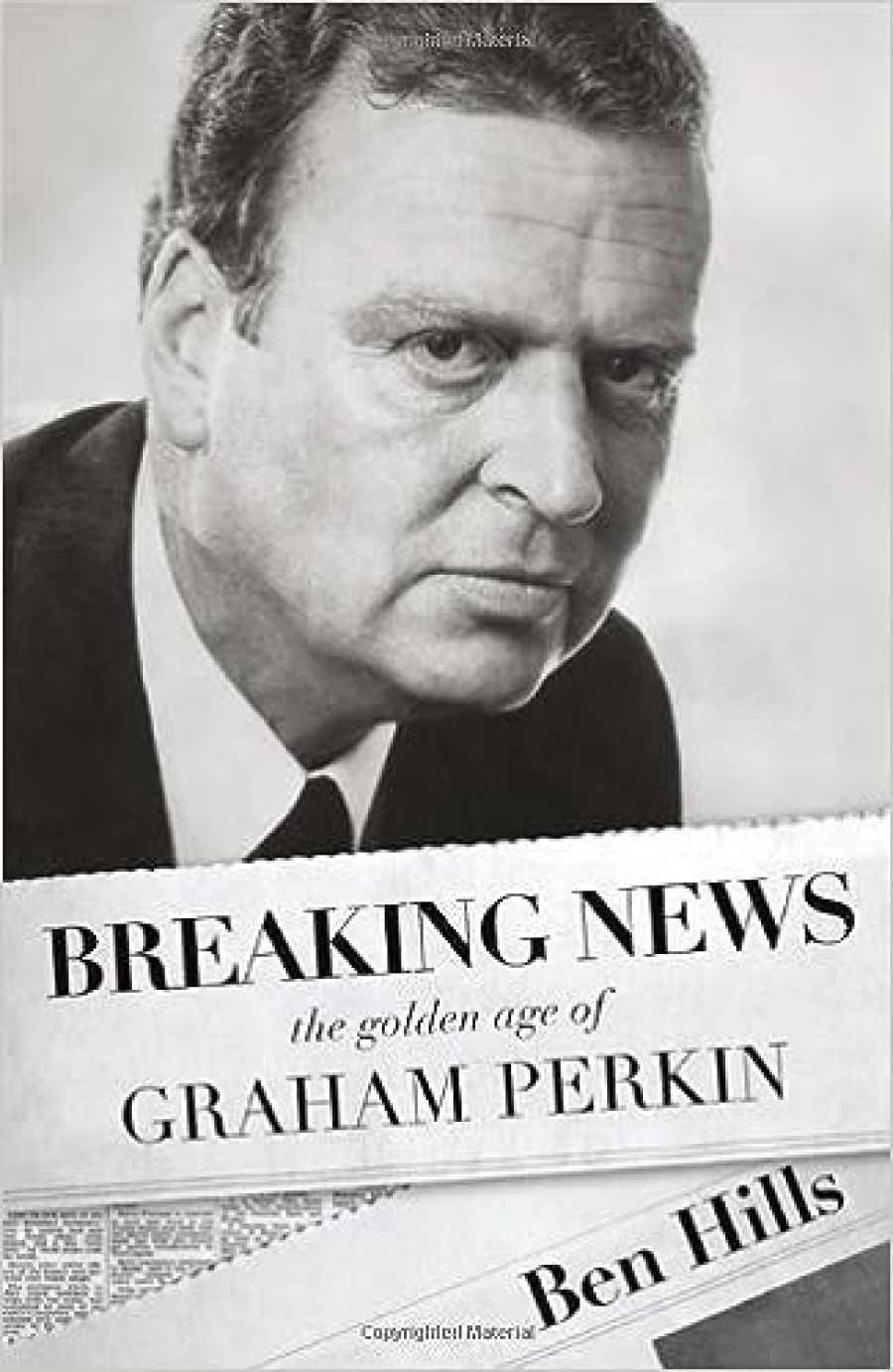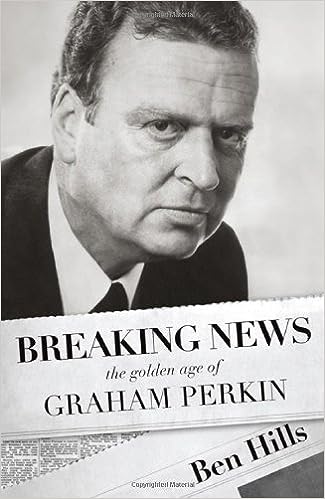
- Free Article: No
- Contents Category: Biography
- Review Article: Yes
- Article Title: Man of paper, mind of steel
- Article Subtitle: The editor who defined The Age
- Online Only: No
- Custom Highlight Text:
In May 1981, I joined The Age, where, more or less, I have stayed put. On my first night one of the news subeditors said, ‘Let’s have a drink’. Whereupon he led me away from the news desk, along the scrofulous green carpet, past the ramshackle assortment of desks and typewriters, and straight into the men’s room. Fleet Street used to have a bar, behind St Bride’s Church, called the City Golf Club, which was neither sporting nor exclusive in any way. But The Age went one better, with a late-night hostelry on the third floor of its ugly Spencer Street building that served as a drinking hole because the others were all closed by that hour.
- Book 1 Title: Breaking News
- Book 1 Subtitle: The Golden age of Graham Perkin
- Book 1 Biblio: Scribe, $59.95 hb, 536 pp
- Book 1 Cover Small (400 x 600):

It was an initiation of sorts. Certainly, nothing in subsequent years has equalled the buccaneering brio of that opening night. Later on, to honour that memorable exchange in exclamatory fashion, I devised the Dog’s Dick: a cocktail containing equal parts Bundy and ginger beer. Two of them made you bark.
At that stage, it was getting on for six years since The Age’s most celebrated editor, Graham Perkin, left the building one October night, after writing a leader saying the Whitlam government must go now with dignity, went home, had a heart attack and died. A month later, the Whitlam government, at the behest of the governor-general of the day, Sir John Kerr, went without dignity and with a lot of noise.
Perkin’s death was so sudden, so premature, that his staff could hardly believe it. When I joined The Age, Perkin was still discussed often – not just in the Locker Room, but throughout the editorial floor – almost as if he was still alive, his catchcry, ‘Jesus, chap!’, still resounding through the cavernous, open-plan third floor. His influence, three editors down the track – the last of whom, Michael Davie, would return to England later in 1981, to be succeeded by Creighton Burns – was still palpable, mainly because the Perkin factor lived on in the form of various loyal lieutenants and, indeed, the internal architecture: for years, Perkin’s office, like Miss Havisham’s mansion, remained unchanged, with its wide Victorian-style desk, handsome visitors’ chairs and, in a far corner, an arrangement of 1970s sofas and sling-back leather chairs around a blonde-wood coffee table. This was where the daily news conferences took place under a large portrait of the great cartoonist Les Tanner, painted by June Mendoza. A subsequent editor threw out the furniture (these days, it could have fetched a fortune on eBay), installed himself at a tiny bench-like desk facing the window, and held conference around a dining table.
Now the rest of The Age has removed itself from the Perkin era simply by shifting buildings further down Spencer Street to a gleaming edifice built across the railyards in an area whose transformation Perkin could never have visualised: Docklands. There is little, if any, nostalgia for the old premises – and certainly none of the same affection old-timers in the early 1980s felt for The Age’s Collins Street building. This was where young Graham Perkin from Victoria’s Mallee started his career in 1949 on sport and shipping, general reporting, writing features and subediting; the essential bone-and-tissue that is the physiognomy of any well-rounded journalist. Seventeen years later, Perkin, at thirty-six, became one of the youngest editors of an Australian newspaper. Nine years later, he was dead.
Between these bleak staging posts, Ben Hills (one of Perkin’s ace reporters) has fashioned a biography that is as much about an institution as it is about the man who led it. Breaking News is also a lament for those glory days which, although perhaps never quite so lustrous as Hills paints them, were of a time when newspapers were more adventurous and independent, with generous expense accounts and editors who were unafraid to stand up for what they saw as issues worth tackling for the greater public good.
Breaking News is not, and could not be, a biography of one man. It is of two: Graham Perkin and Ranald Macdonald, the so-called ‘accidental managing director’ and the last Syme descendant to control the paper, who was projected into the job when he was just twenty-six. Without Macdonald, who controlled the purse strings and an often hostile board (neither, as Hills writes, entirely successfully – recalling the brief, and expensive, life of the afternoon paper Newsday, and incursions into Hong Kong and Papua New Guinea), Perkin could not have had the freedom to reshape The Age into what he wanted it to be; without Perkin, Macdonald would not have had the right editor with the necessary credibility, powers of persuasion and force of will to transform the paper into the publication it became. The most fascinating part of this long and complex narrative is the recounting of the events that created this astonishing fusion of extremely different characters (Phillip Adams compared the two as ‘the front and rear end of the panto horse’). Their backgrounds – one, a country boy who came to the Big Smoke and did things the hard way, could have been eulogised by Banjo Paterson; the other, social gadfly, a man of privilege and a business maverick – could have been invented by Evelyn Waugh. You wouldn’t read about it, but one certainly read the product they created together. As Hills says, Perkin’s relationship with Macdonald was ‘the reverse of the normal hierarchy of the business world. When Perkin spoke, it was with brusque authority; a conversation with the effervescent Macdonald could be more like a ride on a merry-go-round at Luna Park.’
The great temptation is to assume The Age rose up to meet Perkin, flourished like never before, and then fell away after his death. But Hills has largely avoided this by widening the narrative and mostly steering clear of the hagiography which he says, early on, Perkin would have never tolerated. He provides a useful history of the paper and its times, especially of the Syme dynasty that controlled it from the 1850s until 1983, when Macdonald, the fourth and last of the Symes to run The Age, left the building. In truth, thirty-five years on, The Age of Graham Perkin looks as old-fashioned in presentation and style as does Gone with the Wind when compared with The Girl with the Dragon Tattoo. Newspapers, so much of the time, evolve on a daily basis, and heaven knows what Perkin would have made of email and Twitter.
What is in no doubt, though, is that Perkin was fiercely independent, and expected his paper and his staff to be so, too. The big issues of the day – the campaign to abolish capital punishment at the time of the hanging of Ronald Ryan; the establishment of the Insight team and revelation of the Housing Commission’s cooked land deals in the early 1970s; the unravelling of the loans affair that brought down the Whitlam government – were pursued with vigour and thoroughness, often in the face of hostile opposition, especially from various governments of the day. For Perkin, there was no such thing as compromise. Declining an invitation to a Liberal Party dinner in 1974, he wrote to the party grandee Ron Walker: ‘I think you will find that editors interpret their ethical responsibilities in different ways. I would not, in any circumstances, attend a Labor Party dinner. To be even handed I must therefore say no to your renewed invitation … this has nothing to do with political beliefs. As I think you know, I have political beliefs, but absolutely no political alignments.’ Later, the book recounts a lengthy enmity between Perkin and one of his political columnists, who stepped over the line from comment to political affiliation.
So: Graham Perkin, a man of principle, morals, and talent. It is fascinating to see how his own writing stands up so well after many years. For example, this paragraph from Perkin’s Walkley Award-winning article on a hole-in-the-heart operation on a young girl at Melbourne’s Alfred Hospital is beautifully written, evocative and eerily prescient:
An exposed human heart is dark red and filled with inhuman independence. It throbs in the opened chest, contorts itself in formless movement and beats out the rhythm of life. Beneath it are the lungs; inanimate off-white objects like supercharged dumplings that slide from view into the outraged privacy of the chest, then pulsate into sight again past the rim of the surgeon’s incision. Here is the fount of life and some of its mystery, bare, bleeding and exposed to the eyes of men. Here is life which might be death.
How does history view Perkin? Many of those who worked with him and knew him well are still alive, and have provided Hills with various valuable insights, as have members of Perkin’s family. Hills has certainly done his work well, adding the ‘why’ and the ‘how’ and the ‘what next’, in the method drummed into him and his fellow reporters by their remarkable editor. On the debit side are a few small but disturbing typos (Jesus, Ben!) and, more seriously, an underestimation of the work done for The Age by one of Perkin’s successors, the late Michael Davie, who valued fine writing, created his own campaigns (‘Give the Yarra a Go’) and was by no means the old duffer that Hills would have us believe. I also think that Keith Sinclair (Perkin’s predecessor, who was sacked by Macdonald) was a far more honourable man than he might appear within these pages.
I am not sure who will read this book, apart from journalism’s practitioners past and present, or students of the craft. This, though, is not the point. Newspapers may fade into history, but they are still historic institutions of enduring power and influence. I found Breaking News enthralling for the greater part. There can be no doubt that Perkin transformed The Age and brought to it a legion of fine journalists who, in turn, inspired newer generations. Whether Perkin (as one critic says) encouraged his staff ‘to think of themselves as a race apart, as much better than other journalists’, or whether one subscribes to the simplistic view that he encouraged journalists and future journalists ‘to find out what’s going on and tell the punters’, the truth of the matter is undeniable: Graham Perkin and The Age made each other what they were.


Comments powered by CComment